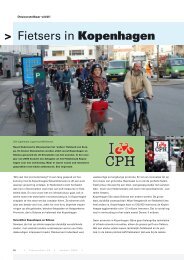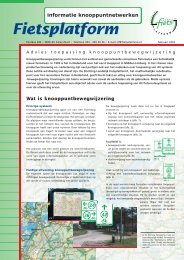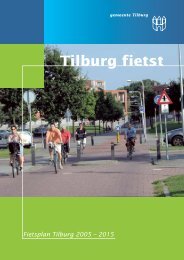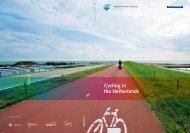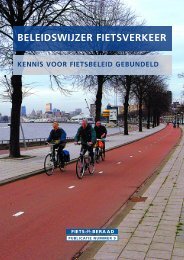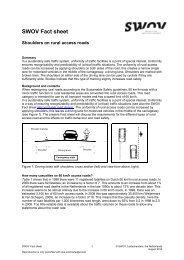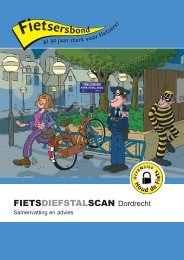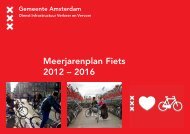Beleving en beeldvorming van mobiliteit - Kennisinstituut voor ...
Beleving en beeldvorming van mobiliteit - Kennisinstituut voor ...
Beleving en beeldvorming van mobiliteit - Kennisinstituut voor ...
Create successful ePaper yourself
Turn your PDF publications into a flip-book with our unique Google optimized e-Paper software.
Summary<br />
.....................................................................................................................<br />
Figure 1<br />
The subjective aspects of mobility have received very little att<strong>en</strong>tion in<br />
traffic and transport research. Most studies have focused on observable<br />
patterns and behaviours. In order to better understand the subjective<br />
aspects of mobility, this report looks at the experi<strong>en</strong>ces and attitudes<br />
related to the use of cars, bicycles and public transport. What is<br />
considered the most <strong>en</strong>joyable form of transport in the Netherlands?<br />
How do people judge travelling by car, bicycle or public transport? How<br />
do people respond emotionally?<br />
The report does not address the question of whether cars, bicycles and<br />
public transport function “well” or “poorly” in an objective s<strong>en</strong>se, but<br />
rather describes how people experi<strong>en</strong>ce the use of differ<strong>en</strong>t modes of<br />
transport and people’s attitudes to them. Experi<strong>en</strong>ce in this context<br />
refers to people’s judgem<strong>en</strong>ts and opinions that are based on the<br />
actual use of cars, bicycles and public transport, whereas attitudes are<br />
more g<strong>en</strong>eral ideas and views that are not necessarily based on real<br />
experi<strong>en</strong>ces. In order to take into account the differ<strong>en</strong>ces in experi<strong>en</strong>ce<br />
and attitudes, a distinction has be<strong>en</strong> drawn betwe<strong>en</strong> frequ<strong>en</strong>t,<br />
occasional and infrequ<strong>en</strong>t/non-users of cars, bicycles and public<br />
transport.<br />
The report not only clearly pres<strong>en</strong>ts the differ<strong>en</strong>ces in experi<strong>en</strong>ce of<br />
and attitudes towards the use of cars, bicycles or public transport, but<br />
also shows what is responsible for these differ<strong>en</strong>ces. Is the perceived<br />
appeal of cars, bicycles or public transport linked to characteristics of the<br />
mode of transport, or are the experi<strong>en</strong>ces and attitudes more rooted in<br />
an individuals’ lifestyle and living situation? The former assumes that<br />
there is a direct connection betwe<strong>en</strong> appeal and aspects of travel, such<br />
as speed, cost, comfort and possible traffic jams or delays. The latter<br />
proposes that appeal is primarily dep<strong>en</strong>d<strong>en</strong>t on individual characteristics,<br />
such as lifestyle and living situation.<br />
SUPPLY<br />
Travel aspects<br />
DEMAND<br />
Individual characteristics<br />
11 <strong>Beleving</strong> <strong>en</strong> <strong>beeldvorming</strong> <strong>van</strong> <strong>mobiliteit</strong><br />
APPEAL of car, bicycle or<br />
public transport


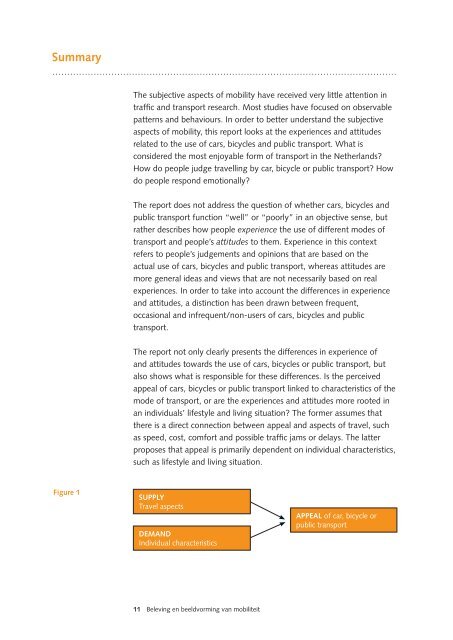
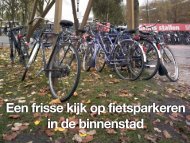
![[plein] - Fietsberaad](https://img.yumpu.com/20829245/1/184x260/plein-fietsberaad.jpg?quality=85)
